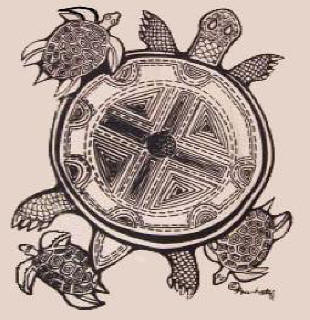 |
LITR 4326
Early American Literature Research Posts 2016 (research post assignment) Research Post 1 |
 |
Andrea Esquivel
Mary Jemison: From Irish to Seneca
As many captivity stories begin, the protagonist, Mary Jemison, was living
happily amongst her family in present-day Pennsylvania. Mary was one of many
siblings and was born in the fall of 1793 while her family was aboard the
William and Mary, the vessel sailing from Ireland to America (“Mary Jemison”).
Like many families who ventured out farther west, the Jemisons too followed
manifest-destiny to a better life for their family to live in peace. Unbeknownst
to them, their life together as a family in the New World would be short-lived
and they would be separated forever.
In Native American beliefs, it is only just to even out the scoreboard, so to
speak, and replace a lost family member with an adopted captive, or retrieve the
scalp of one among those who had wronged the tribe (“Captured By Indians: Mary
Jemison Becomes an Indian”). Since Mary was still young and impressionable, she
was perfect for adoption into the Seneca tribe (“Captured By Indians: Mary
Jemison Becomes an Indian”). Unfortunately for Mary’s family, their debt (by
default) had not been paid in full to the grieving Native Americans who had lost
family members, and so Mary’s mother, father, sister Betsy, and her two brothers
Robert and Matthew were ruthlessly murdered and scalped (Mary Jemison). Only
thereafter had they repaid their debt, and the Senecas carried off Mary to their
tribe and welcomed her into their society (“Captured By Indians: Mary Jemison
Becomes an Indian”).
After her ritualistic capture and the murder of her family, Mary had no choice
but to embrace the new life she was forced into. She was given the name
“Dickewamis”, meaning “pretty…pleasant…[and] good” (“Captured By Indians: Mary
Jemison Becomes an Indian”). Although she was kidnapped and her family was
mercilessly slaughtered, Mary began to understand what her new role in life was
to be—a replacement for a loved one that the tribe had lost. The Seneca believed
in ‘an eye for an eye’, but not in a ruthless vengeful way like the Comanche
did. They simply wanted to fill their loss with another life that could replace
the one that was lost (“Captured By Indians: Mary Jemison Becomes an Indian”).
Essentially, despite the manner in which she was introduced to the tribe, she
was treated with kindness and respect ("Captured By Indians: Mary Jemison
Becomes an Indian").
As Mary’s life with the tribe continued, she married and had a family with
Sheninjee, a warrior of the Seneca, and later another warrior named Hiakatoo,
with whom she had a son named John with (“Mary Jemison”). Although she loved her
children, husband, and friends among the tribe, she couldn’t help but remember
her previous life with her siblings and parents. She missed her family terribly
and while she would have time to herself, she would recite the prayers her
mother begged her not to forget before her untimely death (“Captured By Indians,
1758”). She even named one of her sons Thomas, after her father who fought so
bravely to protect his family and loved Mary dearly (“Mary Jemison”).
Mary Jemison’s story has sold hundreds of thousands of copies due to the
dramatic, heart-wrenching biography that has given students and historians alike
a miraculous view of the life of a Native American captive. She was a brave
woman who never gave up despite the grisly past she had been burdened with since
her childhood. Around 1824, Mary told her story to the minister James E. Seaver,
as she was somewhat illiterate in the English language, and he was able to put
her story down on paper and share it with the world. Mary ‘Dickewamis’ Jemison
died near her hometown in New York among her Seneca peers and loved ones
(“Captured By Indians: Mary Jemison Becomes an Indian”).
Works Cited
"Captured by Indians, 1758." Captured by
Indians, 1758. N.p., n.d. Web. 8 Mar. 2016.
"Captured By Indians: Mary Jemison Becomes an Indian."
Captured By Indians: Mary Jemison Becomes
an Indian. N.p., n.d. Web. 8 Mar. 2016.
"Mary
Jemison." - New World Encyclopedia.
N.p., n.d. Web. 9 Mar. 2016.
"Mary
Jemison, Captivity Narrative from the 1750s (1824)."
Mary Jemison, Captivity Narrative from
the 1750s (1824). N.p., n.d. Web. 9 Mar. 2016.
|
|
|
|


